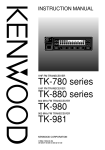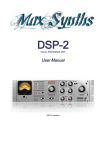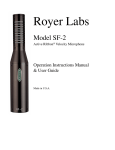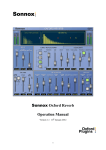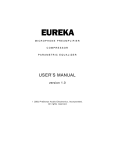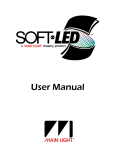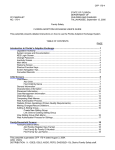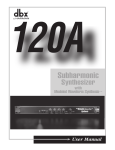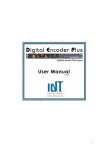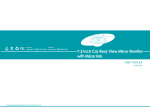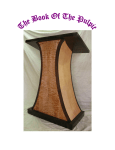Download Unitarian Universalist Church of Fresno
Transcript
Unitarian Universalist Church of Fresno Sound System Basic Operation November 4, 2007 A. Introduction B. Basic “Quick Start” Instructions C. Corded Microphone Input Configuration - Stage Mics and Monitors - Overhead Mics D. More on Input Configuration - Corded Microphones - Cordless Microphones - CD Player - Auxiliary (Portable Players) - TalkBack Mic E. Bringing a Microphone on Line F. Amplifier/Speaker/Monitor Settings - Amplifier Settings - Channel/Fader Settings - Channel/Gain Settings - Monitor Settings - Main ST Settings G. Recording a Service Page 1 of 6 A Introduction 1. This manual is intended to provide a basic orientation to the equipment commonly in use at the church. With any luck, it will get you thru a service and perhaps provide you a basic understanding of the operation of the system. For a more detailed description of the capabilities of the mixer board or other equipment described in this document, please refer to the manufacturers user manual (Contact the Chairperson of the Sound & AV Support Committee). B. Basic “Quick Start” Instructions Step 1 – Turn on the Power to the Amplifiers - These are located in the backstage mechanical room (right side of the stage when you’re looking from the sound booth). Press the red button on the right side of the top unit (Furman Power Conditioner), it should light up and along with it both of the Yamaha Power Amps should light up. The power levels on the amps should be pre-set, but if they’re not then adjust them as follows: - Top Amp (Mains), Left and Right Channels should be pointing to about 12 o’clock - Bottom Amp (Monitors), Left and Right Channels should be pointing to about 10 o’clock Step 2 - Power up the Mixer Board and Auxiliary Equipment- There are two “light” switches mounted on the side of the cabinet to the right of the soundboard. Turn both of these on (indicator light below each switch will glow when each is powered up). These two switches should turn on the: • • • • • • • • Mixer Board Light Board Hearing Assistance Amplifier Foyer/Remote Speaker Amplifier 32 Band Equalizer CD Recorder Deck CD Player Deck Cordless Microphone transceivers (2 each) Step 3 - Check output level and podium mike - Check to make sure there is some power level on the Red “ST” Fader/Slider (This is the main volume for the system, lower right corner of the board). You should start out with it at a level of about 10 - 20 dB on the scale. The podium microphone is normally on input number 7. Make sure the podium microphone channel is turned on, and the phantom power serving this input/bay is turned on. (Press the “ON” button and it lights up.) Adjust the fader/slider on this channel as needed to obtain appropriate volume level. Step 4 - When powering down the equipment, power down the amplifiers last. Page 2 of 6 C. Corded Microphone Input Configuration 1. Stage Microphone/Monitor Pockets - There are 18 pockets on the stage with a total of 16 microphone inputs and 2 monitor outputs. These inputs are number 1 - 16 on the mixer board. (Each pocket on the stage also has two electrical power/110 outlets in it.) These inputs are arranged as follows: 9/10 11/12 M/1 13/14 2/3 4/5 6/7 15/16 8/M 2. Overhead Microphones - There are a total of 6 overhead microphones (these are inputs 17 thru 22 on the mixer board). They are condenser microphones, so you have to make sure the phantom power is turned on to this bay of inputs before you engage the faders. These microphones are numbered as follows: 1 5 6 2 3 Page 3 of 6 4 D. More on Input Configuration 1. Cordless Microphones - There are typically two cordless microphones hooked to the system. • The handheld microphone is on input #15 on the mixer board • The wireless headset is on input #16 on the mixer board 2. CD Player - This unit is located in the bottom of the upper right cabinet in the booth. This unit is hooked to input #29/30. Press the “ON” button for this input channel, insert a CD and adjust the fader as necessary. 3. CD Player/Recorder - This unit is directly above the CD Player in the upper right cabinet. If it is desired to record with this unit, follow the instructions in section G, Recording a service. (If this unit is needed as a second CD playback device, it is hooked to input #31/32.) 4. Auxiliary (Portable Players) - If it is desired to hook up an auxiliary player, there are phono jacks available on the 2TR input on the back of the mixer board. (This is useful for connecting an i-pod or cassette tape player.). If they require a mini-stereo jack, there should be a converter cable in the bottom drawers. 5. TalkBack Microphone - If it is desired to use a “talkback” microphone, the input is located directly above the system main “ST” fader control. This will allow you to speak to individuals on stage thru the monitor speaker system or to the house mains. Select/depress the “1/2” button to talk thru the stage monitors, and the “ST” button to talk thru the house mains, and adjust the volume knob as necessary. E. Bringing a microphone on line. . 1. Plug the microphone and cord into a pocket on the stage. 2. Check the diagram in section C.1 above to see which channel it is plugged into. 3. Make an initial adjustment of the “Gain” for that channel. This is the knob at the top of each column. If you are using a condenser microphone, the initial adjustment should be around the infinity mark (about 10 o’clock). If you are using a dynamic microphone, the initial adjustment should be around 1 o’clock. Normally, you should see the green light next to the slider blinking on and off when someone speaks into the mike or lightly taps it. 3. Slide the fader down to the bottom and turn the power button “ON” for that channel 4. Slide the fader control up to an appropriate volume level. Page 4 of 6 F. Amplifier/Speaker/Monitor Settings 1. Amplifier Settings - The “Quick Start” instructions (section “B” above) provides the basic starting point to insure adequate working levels for system power at the mixer board. If for some reason you feel a need to adjust the basic power levels, the speakers are hooked up as follows: • The larger (15”) center main speakers are hooked up to Channel “A” of the top amplifier • The two smaller (“12”) outer main speakers are hooked up to Channel “B” of the top amplifier. • The left monitor hookup (in the stage floor pocket with mic #1) is hooked to Channel “A” • The right monitor hookup is currently unused (available for future expansion or for a second monitor mix) 2. Channel/Fader Settings -The green light above the channel fader/slider should blink regularly when the gain for that channel is adjusted properly (If the red light comes on too often, it’s set too high). You can press the Pre Fader button (PFS) to send it thru the meter and fine-tune it. When you are running sound for a band or musical group and you’re trying to adjust each of the instruments, make sure you don’t always boost to hear the instrument, sometimes you have bring down the rest so that the one that’s missing can be heard. 3. Channel/Gain Settings - The following are basic guidelines for tweaking the gain settings on an individual channel. (a) High - This is essentially the treble setting. The shelf on this control is at 10 KHz, and is at the very upper end of the typical human voice. (b) Mid/Sweep - This is essentially the mid-range. This is perhaps the most powerful tool in this group of controls. The “sweep” feature lets you choose a specific base frequency in the range of 250 to 5,000 hertz and boost or cut that value. The human voice is primarily in this range, so you can shape the voice considerably with this control (use it sparingly). (c) Low - This is essentially the bass setting. The shelf on this control is at 100 Hertz. If you have a “boominess” in the sound, it is often helpful to cut the low frequencies a bit. (This is very common when miking a guitar with a condenser micropohone; you’ll need to roll off the low gain). 4. Monitor Settings - Both monitor pockets on the stage are currently hooked to the “Aux 1” controls on the board. In order to set up a basic monitor mix, or at least a starting point, do the following: Page 5 of 6 (a) Bring up the “Aux 1” control on the each appropriate input channel to the “unity” setting. Do this for each microphone input channel that you want in the mix. (b) Make sure the Pre-Fader button (just below the “Aux 2 control) is depressed for that channel. This assures that the setting will be consistent on the stage once it’s set. (This should be the default setting for all channels on the board) (d) Adjust the Aux 1 master knob (located on the upper right corner of the mixer board) until you get an adequate sound level on stage. Your goal is to insure the performers can hear themselves and each other, but not to be any louder than necessary as it will cause feedback problems (particularly if any condenser microphones are in the mix). (e) Main Fader/ST Settings - The ST fader is the main volume setting for the house speakers. You should try to adjust this to an initial volume setting and then mix each channel from there. If you raise or lower this fader, it will raise of lower the entire mix to the house/main speakers G. Recording a Service - The CD Recorder operation is very similar to that of a cassette recorder. Basic steps are as follows: 1. 2. 3. 4. 5. Insert blank CD-RW disc into the unit Wait for the unit to read the disc. Display should read “Blank Disc” Press the RED record button. It should automatically engage the “pause” function. Press the PLAY button When finished recording, press the stop button, press the finalize button, then the “jog” button to confirm. (One CD is only good for about 70 to 80 minutes. You can pull out a full disc and finalize it later if necessary) Page 6 of 6






